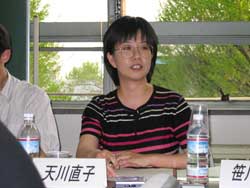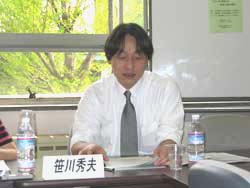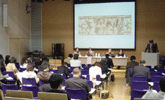CGS 4th Workshop:
"Purges under the Pol Pot Regime: The Anatomy of a Massacre"
Programm
Date: April 17 th , 2004 (Saturday) 15:00 - 17:30
At: Tokyo University , Komaba Campus. Building 8, Room 405 (4 th Floor)
◇Chair: Shin'ichi Takeuchi (Institute of Developing Economies, JETRO)
■Presentation: Naoko Amakawa (Institute of Developing Economies, JETRO)
◇Commentator: Hideo Sasagawa (Institute of Asian Cultures, Sophia University )
■Paper Outline
Naoko Amakawa (Institute of Developing Economies, JETRO)
This paper consists of four sections:
1. The process of the establishment of Pol Pot's regime;
2. The various aspects of the killings perpetrated in the Pol Pot era;
3. The eastern district purges;
4. In conclusion.
1. The process of the establishment of Pol Pot's regime
The beginnings of the communist movement in Cambodia which gave rise to the Pol Pot regime, can be found in the establishment of the Communist Party of Indochina in 1930. The communist movement in French Indochina originated amongst the Vietnamese, but its ultimate goal was not the independence of Vietnam but of French Indochina as a whole. However, during the Indochina War (1945-1954), an awareness dawned of the necessity for a party in each of Vietnam , Laos and Cambodia . In 1951 the division of the Communist Party of Indochina into three distinct parties was finalized. In Cambodia , the Khmer People's Revolutionary Party was formed.
The Khmer People's Revolutionary Party suffered from the defection of veteran activists to North Vietnam and suppression at the hands of Shihanouk, and by the end of the 1960s had diminished to a very minor political power. The fact that young men such as Pol Pot, who had first come into contact with the communist movement during his time spent studying in France, and who joined the party after the Indochina War, could become major party players in the 1960s, is largely thought to be due to a lack of suitable party members and the collapse of the party's activities in rural areas.
It was Lon Nol's Coup d'Etat of 1970 which granted the struggling Cambodian Communist Party the conditions necessary for sudden growth. Shihanouk, who had been exiled from the country, became convinced by the arguments of China and Vietnam and declared the formation of a United People's Front. The Cambodian Communist Party (as it became in 1966) under Pol Pot's leadership participated in this movement, and borrowing the name of Shihanouk, this made the mobilization of people for their cause possible.
It required approximately one year from when, on April 17 th 1975 , the United People's Front marched upon the capital Phnom Penh , until Pol Pot and the Communist Party leaders dominated the national political stage. In April 1976, the resignation of the head of state, Shihanouk, and the formation of the Pol Pot cabinet were announced. However, the existence of the Communist Party itself remained a secret.
From the above details, the question arises as to the extent of the internally accepted legitimacy of the Pol Pot regime. The fact that they operated without revealing their very existence and used terror as their main ruling force, suggests that Pol Pot and his fellow party members themselves at least cannot have truly believed in the legitimacy of their rule.
2.The various aspects of the killings perpetrated in the Pol Pot era
It is said that between one and two million people died in Cambodia during the “three years eight months and twenty days” of the Pol Pot era (April 17 th 1975 to January 6 th 1979). As the population of Cambodia at the time that Pol Pot seized power was estimated to be between seven and eight million, this leads to a calculation of between 13% and 29% of the total national population losing their lives in this span.
This massive death toll can be divided into three categories depending upon location and method.
The first category is that of “people arrested by the S-21”. The S-21 was a special police force linked directly to the central party government. At least 14,000 people were captured by this force, but of these, only twelve lived to see the end of the Pol Pot era.
The second category is of “people killed in their villages”. During the Pol Pot era, prisons and execution grounds were established in each region. The number of people killed in these regional “public safety” facilities is unknown. At present, we can only say that the number is extremely high.
The final category is that of “death from illness or debility”. There may be those who disagree with this listing of “death from illness or debility”, which is technically death by natural causes, alongside the former two categories, which are deaths at human hands. However, the excessive amounts of forced labour, the extremely poor nutrition provided by the communal dining and the desperately substandard state of available medical treatment combined to drive many people to death when they would not have done so had the Pol Pot regime not been in place. Thus, as I view these deaths as “unnatural”, I choose to list them alongside the others. There are also many reported cases of combinations of food and labour conditions so harsh that one can only say that the intention was to starve the victims to death. These victims were former soldiers in Lon Nol's army, “new people” (people who lived outside the liberated area before April 17 th 1975 ; particularly urban citizens) and convicted criminals.
So, why was it that these people were designated to be purged? The answer is that they were officially deemed to be “enemies”. In the early part of the Pol Pot regime, this vague term referred to those who “worked for Lon Nol”, but by the end of the regime it had come to refer to those who “cooperated with the Vietnamese”. The latter category was also discussed using such racist rhetoric as “a Khmer body with a Vietnamese heart” or “a Cambodian body with a Vietnamese head”.
3. The eastern district purges
From 1977, the Pol Pot government started to launch cross-border attacks against Vietnam . In late 1977, the Vietnamese army advanced into Cambodia along a national highway, sending shockwaves through the Pol Pot government. The central government decided that the reason the Vietnamese army had succeeded in this endeavour was that there were “enemies” in the eastern districts, and they embarked in purges of the leadership of the eastern districts in March and April of 1978.
What is noteworthy about the eastern district purges is that not only the military leadership, but also ordinary citizens, were deemed to be latent Vietnamese sympathizers. In the latter half of 1978 the central districts army, which had the total trust of the central government, was sent to massacre civilians all over the eastern districts. The number killed is estimated at somewhere approaching 100,000. Those that were not killed were forced to migrate to the north west of the country, after being made to wear clothing (blue krama ) which would clearly distinguish them as being from the eastern districts
3. In conclusion
I have outlined above the historical development of the Pol Pot regime and the various aspects of the killings perpetrated under its rule. I would like to conclude by identifying two issues for further research.
First, while the S-21 has already been comprehensively and comparatively elucidated, the system of regional prisons and execution grounds, which produced dozens of times more victims than the S-21, has only seen fragmentary accounts produced, and a picture of the reality of this system has yet to emerge. Efforts should certainly be made to show that the punishments meted out during the Pol Pot era constitute an act of state-level violence perpetrated by a governmental organization.
Secondly, the hereto considered issue of why the Pol Pot regime killed so many of their compatriots should be discarded, and the issue of “enemies” of the state should be further explored. During the Pol Pot era, many different types of “enemies” emerged. A consideration of this concept of the “enemy” might be very fruitful in this context.
■Outline of Comments 
Hideo Sasagawa( Institute of Asian Cultures, Sophia University )
While the policies of the Pol Pot government are often described as “ultra-nationalist”, there is not yet a large body of research compiled among modern Cambodian history, and it is difficult to claim that the characteristics of Cambodian nationalism have been fully debated and clarified. In Cambodia itself, nationalism is considered a product of the modern age, but one comes across much previous research which falls into the trap of confusing eras and identifies the cause of the development of anti-Vietnamese sentiment, the defining feature of Cambodian nationalism, in the pre-modern era, when Vietnam is said to have eaten into Cambodia 's “territory”. However, in this era, Cambodia can hardly be said to have been a territorial state at all, so its boundaries would not even have been clearly defined.
Since its colonization by France in 1863, immigrants from Vietnam have been prevalent in all fields of Cambodian society, from political administration to urban industry to village-based farming and fisheries. Modern Cambodian intellectuals, who emerged as a group as a result of the French language education programme which began to spread in the mid 1920s, began in the late 1930s to criticize the monopoly of government administrative posts by Vietnamese civil servants and the monopoly of industry by those of Chinese heritage. They claimed, through the use of newspapers and other media, that “the weakened race” that was the Khmer were in danger of “extinction”. It is possible to interpret these claims as the assertion of an “us” against which the Vietnamese and Chinese were seen as outsiders, and different to the “us group”. At this point, Cambodian nationalism and anti-Vietnamese sentiment were established.
After achieving independence in 1953, the Cham people of Malay heritage and the minor ethnic groups of the mountainous regions, neither of whom technically belonged to the Khmer race, were spoken of as the “Khmae Islam” (“the Islamic Khmer”) and the “Khmae Lao” (“the high-ground Khmer”) respectively. Such linguistic efforts were part of a goal of ethnic unification through the spread of the concept of a united Khmer people. As a result, in Cambodia an ethnic consciousness as “Khmer” and a national consciousness as “Cambodians” became intertwined, and indeed, the situation remains so today.
In this way, the Vietnamese were expunged as outsiders, while the Cham and other minority ethnic groups were absorbed as a part of the Khmer ethnicity. However, the decision of who to expel and who to embrace was based upon an arbitrary logic, and the possibility of a formerly embraced ethnic group being rejected always existed. Under the Pol Pot regime, as well as the Vietnamese being victims of deportation and slaughter, the Cham people were also expelled from the fold and became the victims of massacres. Further, it is also widely recognized that under the narrow definition of the Khmer race, urban citizens and villagers from the Lon Nol side were also designated as “new people” and suffered a similar fate.
A detailed examination of the development of the concept of nationalism in Cambodia and the concept of “the outsider” should conquer the previously held fixation on the issue of the killing of “compatriots”, and provide a valuable perspective for an academic understanding of the massacres/purges under the Pol Pot regime.
■Summary of the debate
During the debate, the question was raised of what kind of position the large-scale massacres of the Pol Pot regime occupy in the context of modern Cambodian history. It was pointed out that until now, research has tended to stress the “abnormality” of Pol Pot's rule, but in fact it is a phenomenon that can be understood logically. That is to say, that the Pol Pot government which carried out these purges / massacres, shared the typical characteristics of a communist system as well as being the inheritors of an ethnic liberation movement. In this sense, they can be categorized as so-called “national communism”. However, while in most countries which embraced communism, and certainly in the “ethnic communist” wave of the 1960s, the ruling ethnicity often engaged in the expulsion or homogenization of “outside” or “minor” ethnic groups, the fact that in Cambodia this extended to the point of massacre is the most characteristic element of the Cambodian case. Bearing this point in mind, it was argued that there is a necessity to look at the Cambodian massacres not only from the point of view of nationalism, but also to use the concept of “class enemies” as an analytical tool.
There was also debate concerning similarities with the Stalinist system. It is thought that the methods by which the Pol Pot group (a minority group) claimed control of the state were based upon the ideas and practices of Stalin, but it is necessary to identify who was involved in the process of this overthrow of the system by terror and analyze what role they played in society. There were also calls for a more discerning and careful division in the use of the terms “racism” (“jinshu shugi”) and “racialism” (“minzoku shugi”) in future research. Another request was made for the clarification of the death toll, which was put at one to two million. A detailed analysis of the numbers killed by the central party government affiliated S-21, the numbers killed in regional prisons and execution grounds, and the numbers dying of illness, debility or starvation, as well as a clarification of the numbers of perpetrators and conspirators were called for. Debate also went as far as a discussion of the usefulness of the concept of “a complex humanitarian crisis”, commonly used in the field of political studies.



